The individual topics covered in this section are:
1. Tissue-related Artifacts
2. Motion-related Artifacts
3.Technique-related artifacts
I. Tissue-related Artifacts
- Chemical Shift Artifact Chemical shift refers to small changes in resonant frequency due to different molecular environments of nuclei. The ¹H protons of fat, for example, are nestled within long-chain triglycerides and covered by electron clouds. These clouds partially shield the fat protons from the full effects of an externally applied magnetic field. The ¹H protons of water, however, are less shielded because their electron clouds are pulled away from them by the highly electronegative oxygen atom.Because of this differential shielding by electron clouds, a fat proton experiences a slightly weaker localmagnetic field and will resonate at a slightly lower frequency than a nearby water proton. The difference in frequencies is extremely small, on the order of 3.4 parts per million (ppm) or 3.4 x 10-6. At 1.5 T this corresponds to an absolute frequency difference of approximately 215 Hz. At 3.0 T the difference is twice as large, or about 430 Hz.
- In routine MR imaging, spatial position is assigned along the frequency-encode direction on the basis of resonant frequency. If both water and lipid protons coexist in a voxel, the signal emitted by the lipid protons will have a lower frequency than that of the water protons. This mismapping of fat and water pixels results in artifactual white or dark bands, one-to-several pixels in width, on either side of an anatomic object. The artifact is most commonly seen around water-containing structures (liver, kidneys, optic nerves, thecal sac, muscles, nerve fascicles) surrounded by fat. Note in the image below a black band is seen on the left side of each kidney and a white band on the right. The side on which the black band appears depends on whether the the frequency-encoding gradient is increasing or decreasing from left-to-right across the image. In the kidney, knee, and leg examples shown, frequency increases from left-to-right. The image of the thecal sac is an exception; it has frequency decreasing from left-to-right. Hence the dark chemical shift band appears to the left of the thecal sac.
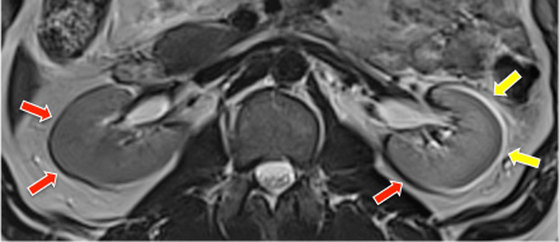
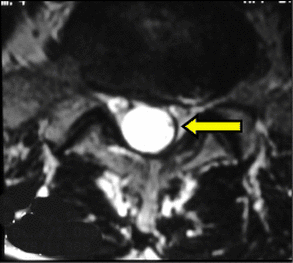 Chemical shift artifact between spinal fluid and epidural fat
Chemical shift artifact between spinal fluid and epidural fat 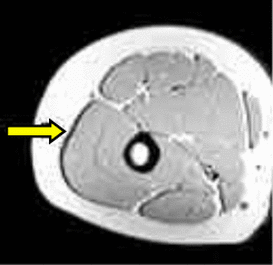 Chemical shift artifact at border of muscle and fat
Chemical shift artifact at border of muscle and fat 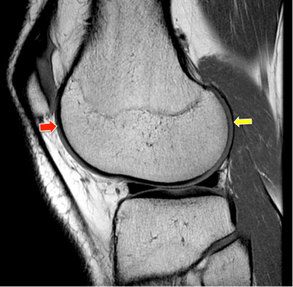 Above: Subtle chemical shift artifact in the knee. Frequency encoding is L to R. Apparent differences in cartilage thickness are artifactual, arising from a shift of marrow fat signal.
Above: Subtle chemical shift artifact in the knee. Frequency encoding is L to R. Apparent differences in cartilage thickness are artifactual, arising from a shift of marrow fat signal. 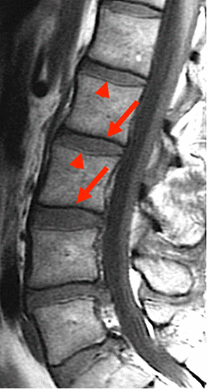 A similar subtle artifact in the spine. Frequency-encode direction is S-to-I. Differential cortical thickness of vertebrae is artifactual due to chemical shift between marrow and disc.
A similar subtle artifact in the spine. Frequency-encode direction is S-to-I. Differential cortical thickness of vertebrae is artifactual due to chemical shift between marrow and disc. - A very subtle form of chemical shift occurs at the edges of bones where fatty marrow abuts a water-containing joint capsule or intervertebral disk artifactually altering the apparent cortical thickness.
- The size of the chemical shift artifact can be readily computed in advance based on two parameters selected prior to imaging: receiver bandwidth and size of the frequency-encode matrix. For example, if the total receiver bandwidth selected is 32 kHz and with 256 pixels in the frequency-encode direction, the bandwidth per pixel is 32,000/256 = 125 Hz. Since the fat-water frequency difference at 1.5 T is about 215 Hz, the size of the chemical-shift artifact will be (215 Hz) ÷ (125 Hz/pixel) = 1.7 pixels.
Reducing the bandwidth per pixel will accentuate this artifact. Narrow bandwidth techniques should therefore generally be avoided in locations where chemical-shift artifacts may obscure important interfaces (for instance, between the optic nerve and orbital fat).
Because the chemical-shift artifact is a spatial mismapping of MR signal based on frequency, it will typically be seen in the frequency-encode direction. (An exception occurs in echo-planar imaging, where chemical shift artifacts are commonly seen in the phase-encode direction. See the next Q&A).
Additionally, in 2DFT imaging, recall that slice selection is defined by variations in frequency. In this method of acquisition, chemical shift artifacts may occur not only within a plane of imaging, but also between slices (i.e., in the slice-select direction). Inter-slice chemical-shift artifacts may appear as dark or light "halos" around certain anatomic structures; others are less obvious and result in subtle degradation of image quality. - Finally, one should be aware that chemical-shift artifacts occur not only between water and fat, but at the interface of any two substances having different chemical shifts. For example, the chemical shift between silicone oil (used in ophthalmology) and water is ~4.4 ppm; between silicone gel (in breast prostheses) and water is ~4.7 ppm. Thus chemical shift artifacts may be seen in locations like the breast, head and neck, and extremities where silicone injections or implants are commonly used.
- What is a chemical-shift artifact?

No comments:
Post a Comment